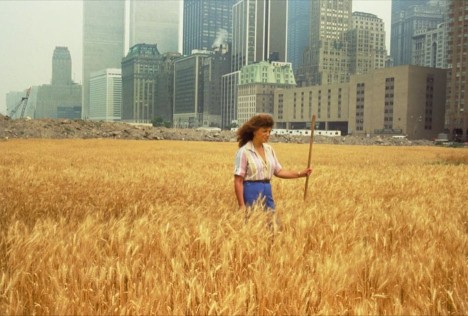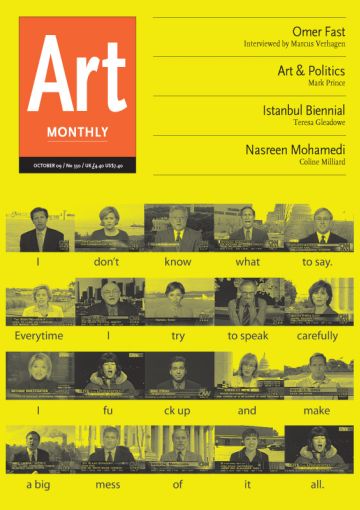Review
Radical Nature: Art & Architecture for a Changing Planet 1969-2009
Colin Perry questions the radical intentions of the Barbican exhibition

Agnes Denes, Wheatfield – A Confrontation, 1982
Just what was it that ‘Radical Nature’ aimed to achieve? This exhibition, the first significant display of recent artistic engagements with ecological issues within a major UK gallery, was disappointingly muddled. Conflicting artistic approaches, strategies and ideologies were presented shoulder-to-shoulder, effectively trivialising their various standpoints. There were messianic mythmakers (Joseph Beuys, Buckminster Fuller), hippie survivalists (Newton Harrison and Helen Mayer Harrison, Ant Farm), dialectic conceptualists (Hans Haacke, Robert Smithson) and tinkering contemporaries (Tue Greenfort, Simon Starling). Where conceptual unities collapsed, topological similarities abounded. On the gallery’s lower floor a dense installation of artworks incorporated living plant life: Hans Haacke’s mound of fecund earth, Grass Grows, 1969; Henrik Håkansson’s hunk of horizontal rainforest imported into the gallery and kept alive with artificial lighting and water pumps, Fallen Forest, 2006; the Harrisons’ indoor vegetable plot, Full Farm, 1972; architect group A12’s garden-like mirrored chamber Green Room, 2009; and Simon Starling’s raft of vegetation, Island for Weeds, first seen at the Venice Biennale in 2003. Curator Francesco Manacorda’s theoretical model here is the ‘binary’ western distinction between ‘culture’ and ‘nature’ that allows the latter to be exploited without repercussions for the former. To destabilise this supposedly widely held notion, he literally merges the two terms by bringing the outdoors indoors. This might seem reminiscent of Smithson’s use of ‘Site’ and ‘Nonsite’, but where Smithson’s model established a dialectical relationship between two locations, this dynamic doesn’t exist with pre-existing artworks. Without this critical bite, the opening gambit of ‘Radical Nature’ resembled little more than a vegetative theme park.
‘Radical Nature’ was not a radical exhibition, and it is unclear whether this was even the intention. Another possibility is that it was intended to be a historical survey of ecological radicalism without itself instantiating any overtly left-wing position. If so, I found it troubling that important strains of activist art were left out. These include those ‘reparative’ artists and architects such as Alan Sonfist, Mel Chin and Patricia Johanson whose work aims to repair directly tracts of damaged land or waterways. Also absent were more contemporary activists working towards ecological justice and Third World eco-politics. This is not a marginal issue: climate change affects fragile areas in Africa and Asia more devastatingly than western ones, since rich countries do not rely on subsistence farming and have robust infrastructures that lessen the impact of droughts, floods and other disasters. So why were non-western artists largely excluded? Beuys, who helped found the German Green Party, was here, but Maria Thereza Alves, the artist who helped found the Brazilian Green Party, was not. Mierle Laderman Ukeles is represented here with her Touch Sanitation, 1977-84, in which she shook hands with workers from the New York City Department of Sanitation, but Ashok Sukumaran and Shaina Anand’s collaboration with Delhi rickshaw drivers, Motornama Roshanara, was not. Recent international exhibitions in Germany (Documenta 11, 2002), United Arab Emirates (Sharjah Biennale, 2007) and India (‘48°C – Public.Art.Ecology’, Delhi, 2008) have firmly established the links between geopolitics and ecology, but this exhibition shirked the task. Similarly, the architectural examples seemed more whimsical than ‘radical’. Diller Scofidio + Renfro’s The Blur Building, 2002, a pavilion created from a haze of fog pumped up from a Swiss lake, and R&Sie(n)’s entropic architecture both blurred ‘nature’ and ‘culture’, certainly, but this seemed obfuscatory in light of the acute reality of the environmental crisis and its global impact on broader communities.
Rather than repeat the depressing (and all-too-familiar) realities of ecological catastrophe, Manacorda sought to create a positive, inspiring exhibition concerned with ‘solutions’. Symbolic, utopian gestures were preferred over critical negativity. Certainly there is a real pleasure to be had from such an approach. Buckminster Fuller’s geodesic domes and his forceful description of earth as a spaceship capture the imagination; Smithson’s iconic Spiral Jetty, 1970, is hypnotic in shape and scale; Agnes Denes’ Wheatfield – a Confrontation, 1982, a two-acre field of golden corn that she cultivated on disused land close to Manhattan’s World Trade Center, is magisterial. But, even accepting this populist approach, some works were simply badly installed. Beuys was represented by the sculptural remnants of Honey Pump at the Workplace, 1977, a weighty system of pipes that pumped two tons of honey around a closed circuit with the aid of a couple of ship’s motors. However, for reasons I can’t fathom, an archival BBC documentary on Beuys was distractingly projected onto the back wall of this space, its soundtrack several decibels too loud. Wolf Hilbertz’s visionary Autopia, fantastical mock-ups of artificial, inhabitable coral reefs, was paired brilliantly next to Ant Farm’s The Dolphin Embassy, 1977, a dippy proposition to establish interspecies understanding between humans and dolphins. However, a documentary film on Hilbertz’s real-world coral building experiments was jarringly loud – why not use headphones? Such display issues dogged the exhibition throughout. More absurdly, while wall texts and benches were made of recycled exhibition material, the massive electrical usage necessary artificially to light and sustain the indoor vegetation undermined the show’s nod towards sustainability.
These utopian or iconic artworks, mostly produced or initiated in the 1970s, were the most galvanizing aspect of ‘Radical Nature’. By contrast, Center for Land Use Interpretation (CLUI) is well known for the neutrality of its documentation of gas pipelines, nuclear depots and coal mines. Other works felt faintly irrelevant beside artists like Beuys and Smithson. Luke Fowler’s video Bogman Palmjaguar, 2007, was a fascinating profile of a man diagnosed as a paranoid schizophrenic living in the vicinity of Scotland’s Flow Country bog, but was largely concerned with the protagonist’s brittle sense of self. Lara Almarcegui’s elegiac wish to preserve the ‘freedom’ inherent in undeveloped urban space in the site of the 2012 Olympic developments along the Lee River seemed lackadaisical and quasi-romantic. Starling’s Island For Weeds, a raft of fauna propped on a set of airtight floats, which related to the uncontrolled growth of rhododendrons imported to Scotland in the 19th century, did not represent him at his best. Tue Greenfort’s auto-portrait photographs of foxes biting into sausages rigged to the shutter release of a camera were jocose but, like others of his generation, understood ecology in a rather dull (or literal) hermetic loop that excluded wider social forces. Perhaps the most vivifying experience was the architect group EXYZT’s off-site project The Dalston Mill, a wind-powered mill and bakery installed in East London alongside a small recreation of Denes’ Wheatfield. It was the perfect place to sip a beer and contemplate what Manacorda nobly attempted but failed to achieve within the gallery space: the fertile marriage of nature and culture.
Colin Perry is a writer and critic.
‘Radical Nature: Art & Architecture for a Changing Planet 1969-2009’, Barbican Art Gallery, London, 19 June to 18 October 2009
First published in Art Monthly 330: October 2009.










